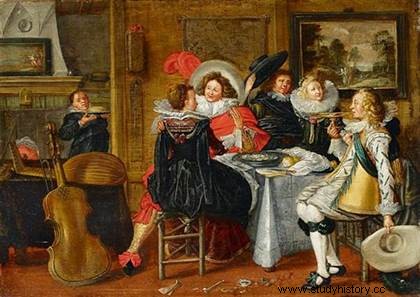 Golden Age of Dutch Painting , the17th century sees the emergence of talented painters, such as Rembrandt, Frans Hals, Jan Vermeer, Pieter De Hooch, Jacob Van Ruysdael and Carel Fabritius, whose art is soon hailed throughout the continent. At that time, the market for artistic production in the Protestant Netherlands was the most dynamic in Europe. The artists do not wait for orders in their studio, they go to meet potential buyers at fairs, thus popularizing their art. Under the influence of Protestantism, subjects borrowed from the Old Testament are rediscovered. In the same way, genres develop and codify, such as portraits, still lifes, landscapes and scenes of daily life, known as genre scenes.
Golden Age of Dutch Painting , the17th century sees the emergence of talented painters, such as Rembrandt, Frans Hals, Jan Vermeer, Pieter De Hooch, Jacob Van Ruysdael and Carel Fabritius, whose art is soon hailed throughout the continent. At that time, the market for artistic production in the Protestant Netherlands was the most dynamic in Europe. The artists do not wait for orders in their studio, they go to meet potential buyers at fairs, thus popularizing their art. Under the influence of Protestantism, subjects borrowed from the Old Testament are rediscovered. In the same way, genres develop and codify, such as portraits, still lifes, landscapes and scenes of daily life, known as genre scenes.
The Golden Age of Dutch Painting
While mythological painting was still the dominant genre practiced by a majority of European artists, some Dutch painters, on the contrary, endeavored to represent seemingly innocuous gestures. Genre painting was not interested in known characters, it was not the goal. This one is different and that is why anonymous individuals are represented. It was, in the words of the essayist Tzvetan Todorov, to “represent what is”. It was, and indeed is still a current debate to understand the meaning of these paintings. Is there only a representation of everyday life, or is there a moralizing role?
In this sense, the painting entitled "The Holy Family" painted by Rembrandt in 1640 depicts a matron, a mother, her baby and a carpenter working in the background and facing back to the viewer. Should we, considering the title of the painting, see an analogy with the holy Catholic family composed of Mary, Joseph and Jesus? Should we see a simple Dutch family with a father working wood? If Rembrandt made reference to the Holy Family, did he want to show the virtues of family life? We can believe that genre painting actually mixed the two:some artists did not create for a moralizing purpose, while others did.
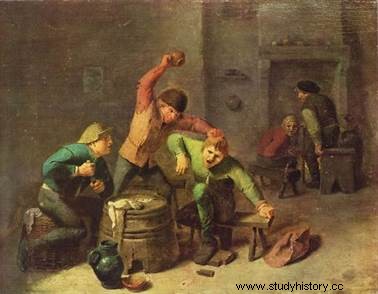 A certain joie de vivre emanates from certain paintings and certain painters have tried their hand at it successfully. Thus Adrian Brouwer painted peasant amusements satirically, in tavern scenes where drunkenness distorted the features of the subjects. Adrian van Ostade (1610-1685) excelled in depicting scenes of the merry company of the working classes.
A certain joie de vivre emanates from certain paintings and certain painters have tried their hand at it successfully. Thus Adrian Brouwer painted peasant amusements satirically, in tavern scenes where drunkenness distorted the features of the subjects. Adrian van Ostade (1610-1685) excelled in depicting scenes of the merry company of the working classes.
In the same genre, Jan Steen (1625-1679), who ran a tavern in Leiden, composed scenes of disorderly houses, where drunkenness, laziness, smoking and lechery were systematically taking over. He also often painted joyful and harmonious pictures like the "Baptism Meal" which is an oil on canvas from 1664 and which shows parents and their friends celebrating the baptism of a newborn baby who has just had venue. In fact, both Protestants and Catholics attached great importance to baptism – which was, moreover, one of the two sacraments, along with the Eucharist, to have been recognized by Luther in the 16th century – and which was supposed to erase original sin. Sacrament, the first, without which the salvation of the newborn could not be assured, and would therefore condemn the soul of the child to wander in limbo, a strange place where suffering and joy are impossible.
Genre scenes in Dutch painting
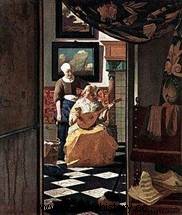 We have just said that in genre scenes, painters represent what is. However, this is not exactly true because if necessary, and the United Provinces having been very often at war, whether in the struggle for independence against Spain, in the maritime conflicts with England or in the Dutch war, shouldn't genre painters have represented battle scenes? Generic painting has in fact nothing to do with battles and wars because it is above all and almost exclusively concerned with the daily life of society. So in "The Love Letter" by Vermeer.
We have just said that in genre scenes, painters represent what is. However, this is not exactly true because if necessary, and the United Provinces having been very often at war, whether in the struggle for independence against Spain, in the maritime conflicts with England or in the Dutch war, shouldn't genre painters have represented battle scenes? Generic painting has in fact nothing to do with battles and wars because it is above all and almost exclusively concerned with the daily life of society. So in "The Love Letter" by Vermeer.
Made around 1669, we see a woman receiving a love letter. The spectator has the impression of being indiscreet. Its precision fascinates. The scene is theatrical, the door is open, the curtain is up. In a rush, the maid, who brought the letter and was most likely eager to do so, dropped her slippers on the floor. The servant seems satisfied to have brought the letter, her arm, relaxed, testifies to it. The gaze of the musician is interrogative. The pearls and the brilliance of the fabrics inform about its rank. The paintings in the background are interesting in many ways.
In fact, the subject of the painting behind the servant confirms the letter. We see a boat setting out to sea. The boat personifies the gallant who sent the letter while the ocean personifies love. Jan Hermansz's book of emblems in love. Doesn't Krul, published in 1634 say that "Love is like a sea, the lover like a vessel"?
Some Famous Dutch Painters
Among the famous genre painters, we must mention Emmanuel de Witte (1618-1692), Gerard Ter Borch, Gabriel Metsu, Vermeer, Pieter de Hooch (1629-1684), who represented almost only women, behaving each time as exemplary mothers and wives as in the oil on canvas entitled "Interior scene with a mother delousing her child", subtitled "a mother's duty". Everything is calm, even the little dog is meditating. The mother carefully inspects her daughter's hair. This scene is a moral lesson for Dutch audiences:isn't prevention better than cure?The scene takes place in a bourgeois yet modest interior. We can see in the right foreground a commode. On the left, the opening to the outside, which brings in the light, which Pieter de Hooch masters perfectly. We also notice some paintings that cover the walls.
Sometimes he also painted pictures representing children standing on the threshold of the door that remained open (Boy with basket, The Room, Kolf's Game, The Messenger). Basically, perhaps he wanted to symbolize childhood curiosity for the outside world, in other words the search for and discovery of the unknown. Above all, it was for him the way to set up his art:the mastery of perspective.
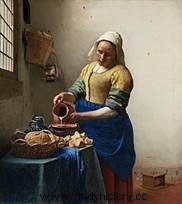 Johannes Vermeer, called in the 19th century the "Sphinx of Delft", was a famous painter of his time, unlike what one reads sometimes, but however his great notoriety was later, while he was the artistic figurehead of Delft. It is his interior scenes that have consecrated him. We owe him among others the Astronomer, the Milkmaid, the Geographer, the Pearl Necklace. In "La laitière" and "La lacemaker", the woman always seems absorbed in her job.
Johannes Vermeer, called in the 19th century the "Sphinx of Delft", was a famous painter of his time, unlike what one reads sometimes, but however his great notoriety was later, while he was the artistic figurehead of Delft. It is his interior scenes that have consecrated him. We owe him among others the Astronomer, the Milkmaid, the Geographer, the Pearl Necklace. In "La laitière" and "La lacemaker", the woman always seems absorbed in her job.
Unlike all the other painters in his country, he hardly painted to live and earn money but much more because he loved it (one could say without exaggerating, if he hadn't been a true professional, that he devoted himself to art as a dabbler), this is perhaps why, according to Todorov, he "transcends the art of his time". Besides, he never changed his pace:he painted an average of three to four works a year.
He is a "fine painter who paints blur", according to the formula of Daniel Arasse. In a majority of his paintings, there seems to be an obstacle between the figure he represents and the viewer. The main object is thus always preceded by a carpet, a table, etc. In “La lacemaker”, the thread is incredibly precise while the rest is rather vague. Basically, Vermeer wanted the viewer to see the thread like the lacemaker.
He painted very few outdoor scenes although two of them became famous, namely "Vue de Delft" and "La Ruelle" . As for the Vermeer man, we know that he was the father of eleven or twelve children (according to our readings, the numbers varied). Around the age of twenty, he had converted to Catholicism, like Jan Steen and Van Goyen. Surprisingly, he died poor, not because of any failure of his works.
As far as the meaning of the generic works is concerned, it seems that the artists sought to show that beauty resides in everything, in every gesture, in every individual. For them, it is no longer a question of making the pictorial dithyrambic of the beauty of an Aphrodite, but much more of making us understand that the beauty of the mother breastfeeding her child can transcend that of the goddess of love.
The symbolism of objects and the representation of women and children
Often objects were hidden behind the realism of the representation but nevertheless had moral significance. To name a few, the broom evokes the cleanliness or moral purity of the home. The letter necessarily refers to love. The mirror signals vanity. Indeed, through the representation of the mirror, the painters wanted to show that the human body can only degrade, even by adding a few artifices and by "making itself beautiful or beautiful".
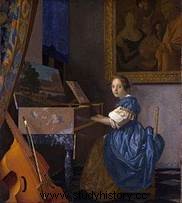 Sexuality could be represented by onions or the presence of a dog ("Le Hachis d 'Onions' by Gérard Dou and the 'Dame à son virginal' by Gabriel Metsu, who was incidentally a pupil of Gerrit Dou) or even a cat. In Jan Steen's "Oyster Eater", a mischievous woman eats a handful of oysters. The precision of each detail recalls the paintings of Gerrit Dou. Clearly emerges from this painting a sensuality represented by the gaze of the young lady and the presence of oysters, which are deemed aphrodisiacs. This symbolism of objects was known to contemporaries and they easily guessed the moral significance of these paintings.
Sexuality could be represented by onions or the presence of a dog ("Le Hachis d 'Onions' by Gérard Dou and the 'Dame à son virginal' by Gabriel Metsu, who was incidentally a pupil of Gerrit Dou) or even a cat. In Jan Steen's "Oyster Eater", a mischievous woman eats a handful of oysters. The precision of each detail recalls the paintings of Gerrit Dou. Clearly emerges from this painting a sensuality represented by the gaze of the young lady and the presence of oysters, which are deemed aphrodisiacs. This symbolism of objects was known to contemporaries and they easily guessed the moral significance of these paintings.
The painting "Woman Reading" by Pieter Janssens Ellinga showed a woman reading in a well-lit room. In the United Provinces, women enjoyed a more pronounced freedom than in France and a fortiori than in Europe. But that doesn't mean we should believe in equality between the sexes:women are nevertheless encouraged to stay at home, to conceive and raise their children. Moreover, many genre scenes invite them to do so. The case of Judith Leyster, already cited, illustrates this well. If she was a great representative of generic painters, the majority of her work was produced before her marriage.
Very often the child embodies disobedience and disorder. But it can also evoke virtue. Sometimes, painters who had few children like Pieter de Hooch (who had two) very often represented children in their paintings while a painter like Vermeer who had twelve children never represented children!
To go further
- Flemish and Dutch Painting. Editions Place des Victoires, 2015.
- Dutch painters in the 17th century, by Wilhelm Martin. Monfort, 1994.
- Vermeer and the Dutch Masters, by Eloi Rousseau. Larousse, 2017.
